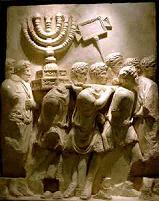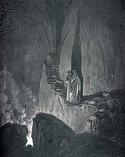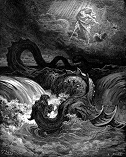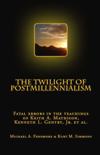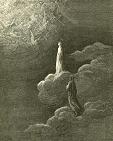The Prophecy of Daniel Seven
Daniel seven is one the greatest chapters of the Bible. If one were to number the ten best known chapters, Daniel seven is likely to be among them. Virtually all students of the Bible are familiar with its imagery. In this article, we want to give a brief explanation of its imagery and historical fulfillment.
Daniel: A Book of
Timelines
One of the most important aspects of the
book of Daniel is the timelines he provides to the kingdom and
coming of Christ.
From the very garden itself, the coming of the Redeemer had been
clearly foretold:
“I will put enmity between thee and the woman, and between
thy seed and her Seed; it shall bruise they head, and thou shalt
bruise his heel” (Gen. 3:15).
However clear the promise of Christ’s coming may have
been, the time when the Savior would appear was generally
indistinct. One early exception was Balaam’s prophecy, which
placed Christ’s coming in the days when “Chittim” was the world
power:
“I shall see him, but no now: I shall
behold him, but not nigh: there shall come a Star out of Jacob,
and a Sceptre shall rise out of Israel, and shall smite the
corners of Moab, and destroy all the children of Seth…Ships
shall come from the coast of Chittim, and shall afflict Asshur,
and shall afflict Eber, and he also shall perish forever” (Num.
24:24).
The “Star” and “Sceptre” are obvious
references to Christ, which Balaam clearly places in the days
However, while Balaam provides certain
markers when the Messiah would appear, they are more in the form
of veiled allusions than explicit statements or timelines.
Daniel alone among the Old Testament prophets provides
actual timelines by which it could be know when the Messiah
would appear. His
prophecies are so explicit that liberal commentators have
imagined they were written ex eventu (after the fact).
Daniel’s final prophecy (Dan. 10-12) is so detailed we
are actually able to trace battles and the shifting about of
power between the Ptolemaic and Seleucid dynasties, the rise of
Antiochus Epiphanes and the Maccabean revolt (Dan. 11:21-39),
the appearance of the Pompey and Julius Caesar (Dan. 11:40-45),
the coming of Christ and the persecution by Nero (Dan. 12:1),
the general (Hadean) resurrection (Dan. 12:2), and the
destruction of Jerusalem (Dan. 12:7-13). There is no other book
like Daniel for its importance and contribution to our
understanding of the kingdom and coming of Christ.
Four World Empires –
Count Down to the Messiah
Daniel seven, like Daniel two, measures the
time for Christ’s appearance against world events, placing his
kingdom and coming in the days of the forth world empire. Both
visions cover precisely the same period and events, but chapter
seven provides greater detail.
Before looking directly at chapter seven, it will be
useful to glace momemtarily at chapter two.
The prophecy of chapter two portrays four
world empires in the form of a human image or idol; the kingdoms
are demarcated by various metals: the first division is a head
of gold, the second chest and arms of silver, the third belly
and thighs of brass, the fourth legs of iron and feet partly of
iron and partly of clay.
We are expressly told that the head of gold is
Nebuchadnezzar’s
The declension in the metals seems to point
in the first instance to the declining glory of the
monarchial power through its division and diffusion in the
successive kingdoms.
Daniel two portrays the coming of Christ as
a Stone, which smites the image upon its feet and toes. This
provides a definite time for the appearing of Christ after the
fall of the Republic and rise of the Empire and August’s
creation of the ten senatorial provinces.
We believe that the Stone’s smiting the image is
eschatological and points to Christ’s second coming and the
world-events attending the “year of four emperors” which left
Rome and Italy in ruins, and marked the coming of Christ’s
kingdom in power. The fall of
The Imagery of Daniel
Seven and the Little Horn
The four kingdoms preceding the advent of
the Messiah, which in Daniel two are portrayed in the human
body, in chapter seven are represented by four beasts.
The beasts are 1) a lion with eagle’s wings, 2) a bear
with three ribs in its mouth, 3) a leopard with four wings, and
4) a fourth beast with ten horns.
Under the law of Moses, each of these beasts were
“unclean,” signifying that they are Gentiles powers.
In the law, certain
animals were set aside as unclean and were not to be eaten by
the Jews. The purpose in these restrictions was not health, but
to separate the Jews from the pagan nations around them. The
dietary restrictions prevented close communion or “table
fellowship” with
Hosea specifically names the beasts of
Daniel’s vision in a prophetic warning that God would chasten
and scatter
“Therefore I will be unto them as a
lion: as a leopard by the way will I observe them: I
will meet them as a bear that is bereaved of her whelps,
and will rend the caul of their heart, and there will I devour
them like a lion: the wild beast shall tear them” (Hos.
13:7, 8)
The connection between Hosea’s
pre-captivity prophecy and Daniel, who wrote during the
captivity, is important to show the historical context and
fulfillment of the prophecy, and that it does not belong to
modern times. Beasts are nations. The nations God used to
chasten
7 – After this I in the night
visions, and behold a fourth beast, dreadful and terrible, and
strong exceedingly; and it had great iron teeth: it devoured and
brake in pieces, and stamped the residue with the feet of it:
The fourth kingdom to rule the inhabited
earth was the strongest of all. The
Roman power grew up slowly, gradually gaining strength and
renown.
and it was diverse from the beasts
that were before it; and it had ten horns.
Daniel says that the fourth beast was
“diverse from the beasts that were before it; and it had ten
horns.” This is an
explicit reference to
“His
professed motive in
this was that the senate might fearlessly enjoy the finest
portion of the empire, while he himself had the hardships and
the dangers; but his real purpose was that by this arrangement
the senators will be unarmed and unprepared for battle, while he
alone had arms and maintained soldiers.”[1]
The division of the empire into imperial
and senatorial provinces became an identifying feature of
imperial
8 – I considered the horns, and, behold,
there came up among them another little horn, before whom there
were three of the first horns plucked up by the roots: and,
behold, in this horn were eyes like the eyes of a man, and a
mouth speaking great things.
A “little horn” is a king. This is seen in
chapter eight, where the identical phrase is used of Antiochus
Epiphanes (Dan. 8:9).
The horn is not “little” compared with the other horns.
All the beast’s horns are little (viz., they are not large like
antlers, but small like the horns of sheep, goats, and oxen).
Thus, it is another little horn among the other
little horns comprising the political powers of the beast.
Specifically, it is the imperial power embodied in the
emperor over against the power of the senate and provincial
governors. The
description of the horn saying it had “eyes like a man and a
mouth boasting great things” points to the blasphemy of the
Caesars, who claimed to be gods and entitled to worship by men.
Daniel says the saints were delivered into the power to
the little horn for a “time, times, and the dividing of time” or
42 month or 3 ½ years (v. 21, 25). This is the same period the
beast in Revelation made war against the saints (Rev. 13:5, 7;
cf. 11:7, 11).
The beast in Revelation is widely recognized as referring
to the persecution under Nero.
He was the sixth “king” in succession from Julius Caesar
(Rev. 17:10) and his name adds up to “666” the mystic number of
the beast (Rev. 13:18).
Thus, it is to Nero the little horn refers and who the
early church recognized as the “antichrist.”
"And so there are many of our viewpoint
who think that Domitius Nero was the Antichrist because of his
outstanding savagery and depravity."
Daniel says three horns were “plucked up”
before the little horn (Roman Emperor).
Note, they are not plucked up by the little horn,
but before (in front of) it.
We believe this refers to the provinces and client kings
that rebelled under Nero:
“a
disaster in
A
common preterist interpretation is that the little horn here is
Flavius Vespasian. This premised on the belief that the three
and a half year period the saints given into his hand speaks to
the Jews’ war with
These verses bear an obvious resemblance to
Rev. 20:4, 11-15, and show that the judgment here is
eschatological and occurred at the time of the general
resurrection.
Indeed, the language of John is almost identical to Daniel:
“And I saw thrones, and they sat upon
them, and judgment was given unto them…and the books were
opened: and another book was opened, which is the book of life:
and the dead were judged out of those things which were written
in the books, according to their works” (Rev. 20:4, 12).
In chapter 12:1, 2, Daniel makes explicit
reference to the resurrection, tying it to the “great
tribulation” (persecution under Nero) and Michael’s (Christ’s)
vengeance upon his enemies. Therefore, although the general
resurrection is passed over in silence here in chapter seven, it
is clear from what we read elsewhere that it was joined in point
of time to the destruction of the little horn (Nero).
11, 12 – I beheld then because of the
voice of the great words which the horn spake: I held even till
the beast was slain, and his body destroyed, and given to the
burning flame. As
concerning the rest of the beasts, they had their dominion taken
away: yet their lives were prolonged for a season and time.
The little horn was destroyed by the coming
of Christ (v. 22).
II Thessalonians agrees when it says that the “man of sin” and
“son of perdition” (Nero) would be consumed by the spirit of
Christ’s mouth and brightness of his coming (II Thess. 2:8).
Thus, if slaying the beast here is the fall of
13, 14 – I saw in the night visions,
and, behold, one like the Son of man came with the clouds of
heaven, and came to the Ancient of days, and they thought him
near before him. And
there was given him dominion, and glory, and a kingdom, that all
people, nations, and languages, should serve him: his dominion
is an everlasting dominion, which shall not pass away, and his
kingdom that which shall not be destroyed.
This is the ascension of Christ, when he
was given dominion over earth’s people and sat down at the right
hand of God. John
portrays these same events in Rev. 4, 5, and 12.
This “going away” is set over against Christ’s “coming”
in v. 22. Together
these fulfill the parable of in Luke 19:12, “A certain nobleman
went into a far country to receive for himself a kingdom, and to
return.” Christ
received a kingdom as a matter of law at his ascension,
he put his enemies beneath his feet and obtained the dominion as
a matter of fact in the events of A.D. 68-70.
17, 18 – These great beasts, which are
four, are four kings, which shall arise out of the earth.
But the saints of the most High shall take the kingdom,
and possess the kingdom for ever, even for ever and ever.
The Jews mistook the prophets, believing
that the Messiah would mark the end of the political and
military dominion of Rome, but the kingdom and dominion would
accrue to the saints another way.
Proclamation of the gospel and Christ’s providential
government of the world and nations would guide history to the
continuous increase of his kingdom, until the gospel covered the
face of the earth.
19, 20 – Then I would know the truth of
the fourth beast, which was diverse from all the others,
exceeding dreadful, whose teeth were of iron, and his nails of
brass; which devoured, brake in pieces, and stamped the residue
with his feet: And of the ten horns that were in his head, and
of the other which came up, and before whom three fell; even of
that horn that had eyes, and a mouth that spake very great
things, whose look was more stout than his fellows.
The horns which were “plucked up before”
the little horn in v. 8 are here “fall” but in v. 24 are said to
be “subdued.”
Following the rebellion of
21, 22 – I beheld, and the same horn
made war with the saints, and prevailed against them; until the
Ancient of days came, and judgment was given to the saints of
the most High; and the time came when the saints possessed the
kingdom.
There are several parallel passages in
Revelation:
|
And
when they have finished their testimony, the beat that
ascendeth out of the bottomless pit shall make war
against them, and shall over come them and kill them.
Rev. 11:7 |
|
And
it was given unto him to make war with the saints, and
to overcome them: and power was given him over all
kindreds, and tongues, and nations.
Rev. 13:7 |
|
These shall make war with the Lamb, and the Lamb shall
overcome them: for he is Lord
of lords, and King of kings: and they that are
with him are called, and chosen and faithful. Rev. 17:14 |
The Ancient of Days is Christ in his
divinity. The little
horn’s persecution of the saints would end with the death of
Nero in A.D. 68 by the coming of Christ in judgment upon the
Jews and Romans.
Jesus’ first century coming was a prominent part of his
teaching. Over and over, he told his disciples that he wold
return in their lifetimes.
“But when they persecute you in this city flee ye into
the next, for verily I say unto you, ye shall not have gone over
the cities of
23, 24 – Thus he said, The fourth beast
shall be the fourth kingdom upon earth, which shall be diverse
from all kingdoms, and shall devour the whole earth, and shall
tread it down, and break it in pieces. And the ten horns out of
this kingdom are ten kings that shall arise: and another shall
arise after them; and he shall be diverse from the first, and he
shall subdue three kings.
The “ten kings” that arise out of beast are in fact the provincial presidents and governors who persecute the church with Nero. John thus says: “And the ten horns which thou sawest are ten kings, which have received no kingdom as yet; but receive power as kings one hour with the beast. These have one mind, and shall give their power and strength unto the beast. These shall make war with the Lamb, and the Lamb shall overcome them: for he is King of kings, and Lord of lords” (Rev. 17:12-14). The provincial governors are not kings, but receive power “as kings” in the persecution, meaning that they hold the power of life and death in the war against the church.
25 – And he shall speak great words
against the most High, and shall ear out the saints of the most
High, and think to change times and laws: and they shall be
given into his hand until a time and times, and the dividing of
time.
“Changing times and laws” signifies carnal
aspirations to divinity.
This is precisely what St. Paul said of Nero in his
epistle to the Thessalonians:
“Let no man
deceive you by any means: for that day shall not come, except
there come a falling away first, and that man of sin be
revealed, the son of perdition; who opposeth and exalteth
himself above all that is called God, or that is worshipped; so
that he as God sitteth in the temple of God, shewing himself
that he is God” (II Thess. 2:3, 4).
Nero’s ascription of divinity to himself set him on a
collision course with Christ.
The Jews would thus accuse Christians to Nero and move
him to persecute the church, and the “mystery of iniquity” that
was restrained when Paul wrote would break out in a surfeit of
blood. Bishop
Lightfoot comments upon this verse:
The
mystery of iniquity was already working,’ when the apostle wrote
this Epistle, which cannot possibly be understood but of the
Jewish nation; and so it is explained again and again.”[6]
Nero’s persecution lasted from November
A.D. 64 until his death June A.D. 68, 42 months or 3 ½ years –
here described by Daniel as a “time, times, and the dividing of
time.”
26, 27 – But the judgment shall sit, and
they shall take way his dominion, to consume and to destroy it
unto the end. And the kingdom and dominion, and the greatness of
the kingdom under the whole heaven, shall be given to the saints
of the most High, whose kingdom is an everlasting kingdom, and
all dominions shall serve and obey him.
The kingdom is not the church. The kingdom
is the inhabited earth.
The four kingdoms that occupy Daniel’s vision each ruled
the inhabited earth.
This dominion, however, was given to Christ.
The saints enjoy the benefit of his reign, as he guides
all things for the advancement of righteousness and his gospel.
Summary & Conclusion
The second coming is clearly set in the
time of the “little horn” of Daniel seven.
Historical evidence plainly shows the little horn to have
been Nero: He meets the criteria of having ascribed to himself
divinity, persecuted the saints for 3 ½ years, and was destroyed
by the coming of Christ’s kingdom in power to vindicate his
gospel and avenge his saints.
[1]
Dio Cassius, LIII, ii-xii; Loeb ed.
[2]
“Africa,
Numidia, Asia, Greece with Epirus, the Dalmatian and
Macedonian districts, Crete and the Cyrenaic portion of
Libya, Bithynia with Pontus which
adjoined it, Sardinia and Baetica were held to belong to
the people and the senate; while to Caesar belonged the
remainder of Spain,— that is, the district of Tarraco
and Lusitania,— and all the Gauls,— that is, Gallia
Narbonensis, Gallia Lugdunensis, Aquitania, and Belgica,
both the natives themselves and the aliens among them.”
Dio Cassius, LIII, xii; Loeb ed.
[3] W. T. Arnold, The Roman System of Provincial Administration to the Accession of Constantine the Great (Oxford, 1879; 2nd edition printed 1906), 104
[4] Bernard W. Henderson, The Life and Principate of the Emperor Nero (Oxford University Press, 1903), p. 15
[5]
Suetonius, Nero,
XXXIX; Loeb ed.
[6]
John Lightfoot, Complete Works,
Harmony of the New Testament (A.D. 1684), Vol. III, p. 232.
To receive Kurt Simmons’ e-mail newsletter, The Sword & The Plow, click the Subscribe link:
All rights reserved.
